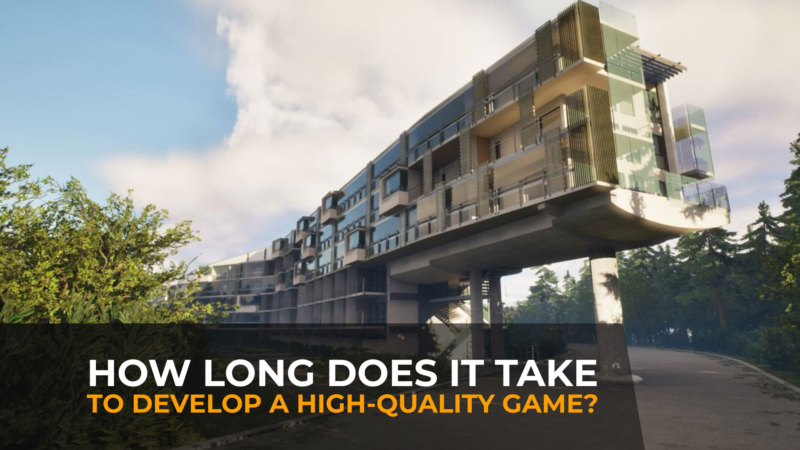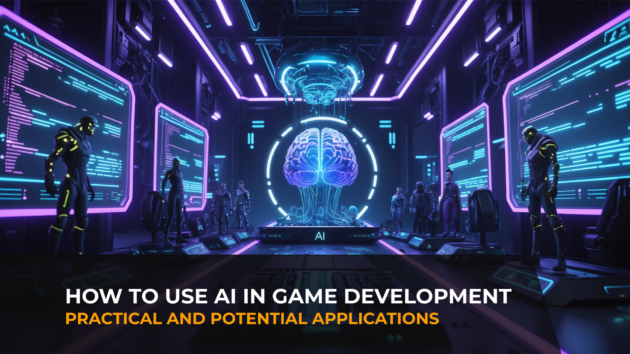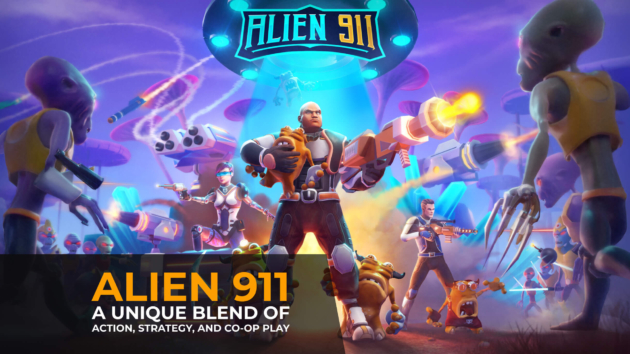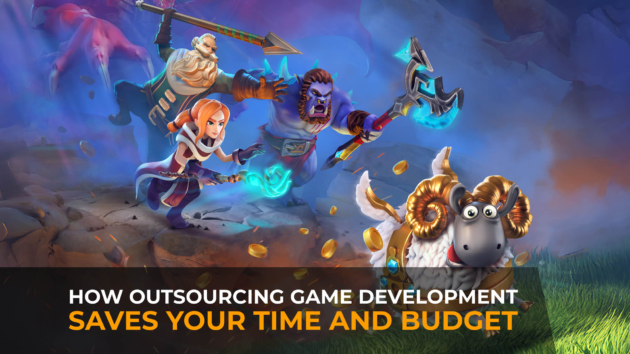The creation of games is a marathon, not a sprint. After all, to make the game one-of-a-kind and infuse it with unique concepts and ideas, you’ll need to invest a lot of effort, time, and patience.
When one hears “game development,” usually, the first question that comes to mind is, “How long does it take to make a game?” And not just any game, but the timeless masterpiece that captivates millions of players worldwide.
In this article, we will delve into the intricacies of game development, highlighting the factors that influence the game development time and comparing timeframes required to create games for mobile, console, and PC platforms.
Factors Shaping the Average Game Development Time
Development Team
A game can be developed in a couple of months or a decade. One of the factors that hold sway over establishing project timelines is the size and expertise of the development team. The number and skill of professionals on board matters, especially for projects on a larger scale. The bigger and more seasoned the team, the less game development time is typically required.
Rockstar North had a team of 1000+ people working on GTA 5 for 5 years, 3 of which were spent on full-scale production. How long would it take to develop a game like that with just one specialist involved? Well, hypothetically speaking, if one person (given that they’re an expert in all must-have aspects of game development) were to make a game like GTA 5 by themselves, it would take approximately 3087 human work years to cross the finish line.
Game Complexity
A video game’s complexity doesn’t always derive from its size. Instead, it stems from intricate gameplay mechanics, sophisticated artificial intelligence, and detailed narrative structures. It can be a multicomponent game that needs to be capable of operating on diverse platforms, necessitating scalability, robust security measures, error-handling capabilities, and dependable databases. Often, the development incorporates integration with multiple systems. What’s more, developers strive to create a balance between players in online multiplayer games and boss fights in offline titles to avoid rage quitting, which can be a rather daunting and time-consuming task.
RPG games with branching paths, especially those that impact the game’s narrative (Cyberpunk 2077, TES: Skyrim, and Fallout), simulation races (Forza Horizon), physics-based titles (Human: Fall Flat), and MMORPGs (World of Warcraft) are examples of complex genres to make that eat up a lot of game development time.
Visuals and Animations
Game art is yet another factor influencing the average game development time. A 3D title in a realistic art style will undoubtedly take more time to develop than a cartoonish 2D one. The making of AAA games with an open world featuring an abundance of NPCs and unique environments with intricate details will move at a glacial pace.
Red Dead Redemption 2 features a tremendous level of detail and the amount of animated objects, being declared one of the most detailed games of all time. For example, if the player zooms in on a squirrel eating nuts, they’ll see the whole elaborate process of peeling the nut and its consumption piece by piece. The same goes for the food on the main character’s plate and the workers constructing the railroad. It took 8 years to make and launch the game with so much detail.
Sound Effects
The incorporation of sound effects in the game contributes to a lifelike experience by reproducing sounds from the real world. Footsteps, the rustling of leaves, hissing and groaning of zombies, weapon handling, explosions – it’s all a task for a sound artist that can take up to a few months of game development time.
Many games include music, whether it’s composed specifically for the game or pre-existing tracks. Creating new sound effects or getting rights for using existing ones can slow down game development due to the work complexity and legal issues. Call of Duty was sued for utilizing copyrighted sound effects without obtaining proper permission, causing a postponement in the game’s launch.
Video Game’s Development Phases and Their Duration
Before answering the question “How long does it take to make a good game?”, it’s imperative also to delve into the process of game development itself, connecting the dots between each stage to gain a comprehensive understanding of the intricacies involved.
Gamedev companies typically structure game development into six key phases:
1. Conceptualization
Duration: Weeks to a few months
During this initial phase, the team engages in brainstorming sessions to conceptualize the game, considering aspects such as genre, gameplay mechanics, art style, target audience, and desired game engine. Market research is conducted to identify trends, pore over competitors, and assess potential opportunities. The chosen concept is then detailed in a game design document (GDD) outlining gameplay flow, central features, and the overall vision.
2. Pre-Production
Duration: From several weeks to a year
This stage helps with setting the game development time for the project and allocating resources. The team solidifies the game design, incorporating elements such as level layouts, character designs, and UI mock-ups. Technical requirements, including platform compatibility and necessary software tools, are outlined as well.
3. Development and Art Production
Duration: A couple of months to years
During the production stage, programmers focus on coding game mechanics, implementing user interfaces, and managing in-game systems. Game artists cover the development of 2D or 3D assets, environment and character design, and visual effects that align with the game’s aesthetic.
4. Quality Assurance
Duration: Weeks to months
QA testers provide comprehensive feedback from their thorough search for bugs and performance issues and conduct A/B testing to gather insights from a broader audience, honing the game further.
5. Launch
Duration: Days to weeks
With the game polished and ready, it is deployed to target platforms, adhering to all required guidelines and requirements. Game developers ensure all requirements are met for a seamless launch, while the marketing team raises awareness and captures player attention using modern approaches.
6. Post-Release Maintenance
Duration: Ongoing
Following the launch, the development team engages in post-production maintenance, implementing upgrades and bug fixes. Experts examine game metrics, oversee player feedback, and introduce new features to ensure the title remains captivating and is on everyone’s radar.
How Long Do Video Games Take To Make? Mobile vs Console/PC
Average game development time for these platforms depends mostly on the game genre, complexity, and budget. But it goes without saying that making a game of equal size for console and desktop takes more time than mobile game development.
How Long Does It Take To Make a Video Game for Console and PC?
Indie games
Indie games, puzzles, and sports games without much intricacies are the fastest to make for these two platforms. They feature simple mechanics and graphics, both 2D and 3D. These genres often serve as a breeding ground for experimentation, fostering the creation of inventive mechanics and engaging narratives.
How long do small video games take to make? On average, developers spend from half a year to 3 years to create indie titles. Portal, a puzzle platform game full of levels requiring skillful space and gravity manipulation, was developed in 2 years and 4 months.
Mid-core, AA games
Bigger titles feature more advanced graphics, and their budget allows for additional features and longer playtime. These games often involve a more extensive development process, encompassing detailed storytelling, complex game mechanics, and open-world environments, although quite limited in comparison to those in AAA games.
Typical genres include simulations, action games, survival, horror titles, and shooters and take up, in general, from 2 to 4 years. A popular action-adventure platform co-op game that offers a crazy journey with multiple relationship tests for couples, It Takes Two, took 2.5 – 3 years to develop.
Our blockchain game that falls between AA and AAA caliber, MetaPopit, offers a unique escape room experience filled with puzzles and adventures. It required 12 months of demo version development, including 3 months of pre-production. The demo consists of three fully designed rooms, 11 unique puzzles, and one mini-game. It serves as a solid foundation for further development of puzzle rooms for the game, as well as new exciting mechanics, which we look forward to.
Large, AAA games
Games of such caliber often feature groundbreaking technologies, experiments with new features, usage of AI, immersive storytelling with branching, top-tier 3D graphics, and a high level of realism in environments. The worlds are broad, filled with numerous characters and quests, all to keep players in the game for a long time. Such titles are extremely demanding and require enormous budgets and development teams.
Genres span a wide range, including expansive open-world RPG games, MMORPGs, action-adventure titles, and first-person shooters. How long does it take to make a game of such a type? Large and AAA games require unwavering dedication, taking more than 5 years to create.
Red Dead Redemption 2, an action-adventure game, a tale of life set in American Wild West, was in the making for more than 8 years. The developers of the famous first-person shooter, Duke Nuken, spent a whole 15 years delivering their masterpiece!
How Long Does It Take To Make a Mobile Game?
Indie mobile games
Small mobile games, such as match 3, puzzles, 2D platformers, endless runners, and slot games – casual & hyper-casual games overall, allow for quick development. They usually feature similar levels, offering little diversity as the player moves on.
The average game development time for indie titles is just a few months. The first version (local mode only) of the famous space-themed multiplayer social deduction game, Among Us, was developed in under seven months.
Mid-core mobile games
These include 3D action games, racing and sports simulators, strategy games, and adventure titles. Such mobile games require medium development, involve intricate decision-making processes, and their visual aesthetics exhibit a broader range.
How long does it take to develop such a mobile game? On average, developers invest approximately up to 1.5 years in creating titles within this complexity tier. The creation of F1 Clash, a racing game that enables players to engage in real-time races and construct their own F1 teams, spanned a period exceeding one year.
In the case of our project, MMA Manager, a title centered on establishing an MMA gym and training fighters, the game development time ranged from 7 to 8 months. Despite its relatively brief development period, the classification of this game as a medium-development one underscores our team’s ability to craft games fast without sacrificing quality. The average timeframe for creating a mobile title of this nature would typically hover around one year.
Large mobile games
Enormous projects for mobile platforms like shooters, RPGs, MMORPGs, and Battle Royale are time-consuming, demanding over 2 years of diligent work, although it’s still not as lengthy as time spent to make average games for console and PC. The intricate nature of these titles, marked by first-class visuals, vast virtual worlds, a plethora of features, and the facilitation of player grouping, significantly contributes to their complexity.
Call of Duty: Mobile, an FPS that offers engaging multiplayer and battle royale modes, expansive maps, and diverse weapons, underwent a development period lasting more than 2.5 years.
The making of Guild of Guardians, a play-to-earn strategy built on blockchain, enabling players to train mighty heroes called “Guardians,” establish guilds, and engage in competitive play for real rewards, spanned a duration of 1.5 to 2 years.
How Game Development Time Could Be Shortened
With each passing day, game development is rapidly evolving, introducing new technologies and breaking ground in graphics. The number of game players worldwide is high, and so is the number of competing game development companies. A swift time-to-market helps ensure that your title establishes itself as a trailblazer and makes a lasting impact on the player community, staying ahead of competitors.
So, how can you shorten game development time? If you don’t have enough human resources and expertise right away to fill in your team and speed up the production, outsourcing the task to professionals is the best option. A good outsourcing partner will expertly cover the expertise & knowledge gaps of your internal team, add a fresh perspective, and ensure timely delivery of your video game. Outsourcing becomes a strategic solution for overcoming resource limitations, allowing you to focus on your core competencies while benefiting from a broader talent pool.
We at Stepico boast 9+ years of experience creating vibrant games of various genres and sizes, from simple puzzles to RPGs and first-person shooters. Our notable projects showcase our dedication to delivering five-star gaming solutions that will leave players craving more. Get in touch with us today to learn more and kick-start your next successful project!




